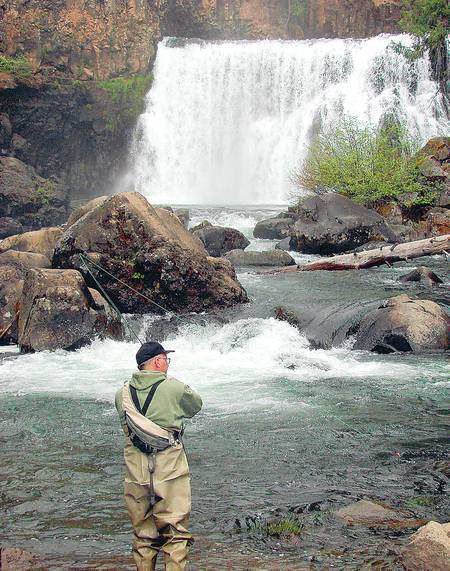Mystical mountain
Published 5:00 am Sunday, June 1, 2008

- Mike Grifantini casts a fly into the McCloud River below Middle Falls, a 50-foot-tall, 100-foot-wide cataract. Grifantini, a fisheries biologist in Redding, an hour’s drive south, was trying to lure rainbow trout. Brown and brook trout, he said, tended to be found farther upstream.
By John Gottberg Anderson • For The Bulletin
MT. SHASTA, Calif. —
Massive Mount Shasta dominates the landscape of the southern Cascade region for hundreds of miles in all directions.
The dormant volcanic peak of 14,162 feet presides over most of Northern California and a good stretch of Southern Oregon. It can even be seen on clear days from the top of Mount Bachelor, 200 miles to its north.
But Shasta is not just any big mountain. In fact, it’s unlike anywhere else. In a region of peaks up to 230 million years old, Shasta is a geological infant, created by eruptions a mere 200,000 years ago.
Seven named glaciers sweep down its slopes. Despite global warming and climate change, one of those rivers of ice has actually increased in size by 30 percent since the 1950s. Shasta is home to rare wildflowers found nowhere else on Earth. Lenticular clouds that form in the local microclimate are occasionally taken to be flying saucers.
And then there are the alleged residents of the mountain. Depending upon whom you talk with, these might include “ascended masters,” Lemurians and Yaktavian bellmakers. Believers claim they all live on or within Mount Shasta, perhaps on a fifth-dimensional plane.
Twenty-one summers ago, thousands of people congregated at Mount Shasta during a planetary alignment for the “harmonic convergence,” which it was said would usher in a new era of universal peace. Today, New Age tourists armed with powerful crystals hire guides to show them portals to secret vortexes, as aficionados of American Indian philosophy venture out on vision quests.
The mountain
The alternative spiritual community presents a unique set of challenges to Eric White, the longtime climbing ranger and avalanche specialist for Shasta-Trinity National Forest.
“This particular user group is very different than others we work with,” said White, who has spent more than half his life on Mount Shasta. “Especially from late July through September, this is an international mecca for the vortex, vision quest, ascended masters followers.”
Many of these seekers aren’t prepared for the dangers and risks of high alpine encounters. Although White takes a proactive approach to climbers’ education that has reduced the necessity of search-and-rescue missions to about 10 a year, he emphasizes that Shasta is not a mountain to be taken lightly with its gaping crevasse riddle glaciers. More snow has fallen here in a single storm — 189 inches in just five days in 1959 — than anywhere else in recorded history, according to White. A 1995 avalanche wiped out a 400-acre forest.
White first summited Mount Shasta in 1985, when he was 19 years old. He’s been with the Forest Service here since 1997, and is a point person for the 8,000 or so climbers who tackle the mountain each year, most of them during the prime May-to-early July climbing season. To first-timers, White recommends the Avalanche Gulch route, pioneered by naturalist John Muir in the 19th century. With a 7,200-foot vertical, it’s a nontechnical climb, although an ice axe, crampons and a helmet are highly recommended.
White warned that the volcano, imposing but docile in appearance, could erupt again in our lifetime. Shasta last blew its top in the 1780s. It’s estimated that, on average, the mountain erupts every 250 to 300 years. Because several communities sit on its flanks, as well as a major interstate highway and rail lines, government scientists closely monitor underground activity.
But if the mountain is getting warmer inside, the evidence hasn’t turned up at the Whitney Glacier, California’s longest.
“This is the only mountain in California where the glaciers are actually growing,” fed by high-elevation snowfall, White said.
Non-climbers will find several excellent hikes on the mountain slopes — especially off the Everitt Memorial Highway, which climbs to Panther Meadows at the 7,800-foot level of Mount Shasta. White recommended the Bunny Flat Trail, a 1.7-mile track with a 930-foot elevation gain to the timberline Horse Camp Cabin, built by the Sierra Club in 1922.
The alternative community
“Even 40 years ago,” said Mike Grifantini, “when I was growing up in Yreka, 40 miles north of here, the people of Mount Shasta seemed just a little bit different than everywhere else.”
Today, Grifantini, a fisheries biologist, makes his home in Redding, 60 miles south. But some of his favorite fishing holes are here, so a couple of times a week, the keen angler may be found casting a line into the McCloud or Sacramento rivers in these precincts.
Occasionally, he’ll venture into the town of Mt. Shasta, whose population of 3,700 makes it slightly larger than Dunsmuir, a historic railroad village a few miles south, or Weed, the highway junction community a short distance north. But it’s more than its size that sets the Mt. Shasta community apart.
For the metaphysically oriented, this is Ashland times three. At least five different shops sell crystals of all types: shaman extraction crystals, Shasta starship crystals, Flame of St. Germain crystals. Thirty different alternative health practitioners, from American Indian shamans to yoga teachers to massage therapists, offer their services through the chamber of commerce directory. Sound therapists will teach you how to bring your body into balance using crystal bowls or tuning forks. Bookstores, astrologers, art and music stores, and even specialized lodgings — like ShasTao, a bed and breakfast that labels itself a philosophical hermitage — cater to a unique clientele.
Most visible of all the spiritual groups is the Chicago-based Saint Germain Foundation, which has a large temple and seasonal amphitheater on the mountain’s west slope. Those who visit its “I Am” reading room on Mount Shasta Boulevard will learn about the ascended masters, the best known of whom is Jesus, and discover “the violet consuming flame,” said to free mortals from the limitations of their earthly imperfection.
Lemurians — descendants of those who survived the cataclysmic destruction of a legendary, Atlantis-like continent in the Pacific — are said to live within the mountain in huge caverns, where they reside in the fifth dimension. Similar claims are made for Yaktavians, who believers say hollow out underground cities and produce light and power simply through sound and vibration; the secret entrance to their cities is supposedly hidden behind a great transparent bell on the mountainside.
Listen to some of the locals, and you’ll hear stories about UFO landings, unexplained healings, blue fairies, eerie sounds and flickering lights on the mountainside. Many of these people are convinced that Mount Shasta is a vortex for spiritual energy or a magnet for cosmic forces. Zen Buddhist monks have established the Shasta Abbey here; they are occasionally seen walking into town from their “temple of radiant wisdom on the solitary, pure white mountain.”
For visitors unfamiliar with the mountain, Shasta Vortex Adventures offers year-round guided hikes or ski and snowshoe trips — and combines its services with shamanic healing, soul retrieval, hypnotherapy and American Indian-style vision quests.
Castle Crags
But it’s not all about the spiritual seekers. This region is also about its tremendous recreational options, whether mountaineering on Mount Shasta, rafting the whitewater of the upper Sacramento River or hiking through the Castle Crags wilderness.
There can’t be many places that offer the “wow” factor of Castle Crags. A 100 million-year-old exposed granite outcropping in the heart of an otherwise volcanic region, the crags are unique outside of the Sierra Nevada. Northbound travelers on Interstate 5 see its sheer spires soaring like a medieval fortress 4,000 feet above them.
“The only other place with comparable features, from the valley floor to the top, is the Yosemite Valley,” Castle Crags State Park ranger Brett Mizeur told me. “And this is right next to the freeway.”
Mizeur has been in charge of the 4,250-acre state park since the spring of 2004. The adjacent Castle Crags Wilderness Area covers another 14,000 acres.
“This park has gone from a purely recreational park to a destination park,” Mizeur said. “It’s up and coming, and it has a lot of potential. This was a landmark to early settlers and to Native Americans before them, so it has a lot of cultural history as well as natural history. We have a general plan for the park that includes a visitor center.”
Day hikers can walk to the base of the rocks, but the climb is not for the timid; the elevation gain on the Crags Trail is 2,200 feet in just 2.7 miles. I enjoyed the less challenging Root Creek Trail, one mile through lush pine forest to a delightfully gurgling stream. A more poorly defined trail continues another half-mile to a hidden waterfall.
But if you hike here, keep your eyes open for wildlife. “There are so many critters here!” exclaimed Mizeur. “We have black bears, mountain lions, mule deer, bobcats, bald eagles, peregrine falcons and much more. About 80 turkey vultures roost in fallen snags in the park every year; they find plenty of road kill to eat on I-5. And we have 13 species of native orchids, more than anywhere else in the country.”
No stranger to Central Oregon, Mizeur was responsible for capturing the lynx that now lives in the High Desert Museum. An apparently abandoned pet, declawed and without its canine teeth, the cat was on the verge of starvation when he captured it last year. Mizeur still visits the animal from time to time: His mother-in-law, Judy Baker, lives in southeast Bend.
Castle Crags is just down the interstate from Dunsmuir, a historic railroad town perhaps best known today for its antique shops. Cafe Madelena is the region’s finest restaurant. After our state park hike, a friend and I enjoyed a delicious meal of creamy gazpacho soup, grilled sea bass and pork loin, topped off with a slice of molten chocolate cake.
McCloud and its river
Ten miles east of Mount Shasta on California state Highway 89 is the charming old lumber town of McCloud. The McCloud River Lumber Co., which once operated the largest pine mill in Northern California, built businesses and homes for its employees around the turn of the last century; it provided delivery of milk and groceries, and established a railroad for transportation. The mill closed in the 1980s, but the McCloud River Railroad still draws a tourist clientele with its Shasta Sunset Dinner Train throughout the summer.
At the Heritage Junction Museum, I met Jimmy Bambino, who showed me his photo in a 1943 high school yearbook. Bambino proudly told me that he had been born and raised in McCloud, as had his wife of 62 years, and there is nowhere else he would consider calling home.
Everything in the one-room museum, from antique phones and typewriters to the baseball uniform of his youth, was from this town of 2,400, Bambino said — everything, that is, but a dental chair said to have belonged to gunslinger Doc Holliday in Tombstone, Ariz. “I have no idea how this got here,” he said.
McCloud has several historic inns as well as a commercial center in the old company store, the McCloud River Mercantile. Today, the interconnected rooms include a cafe, a candy store, an espresso shop, a bookstore and a large gift shop.
Five miles farther east is the McCloud River, whose series of waterfalls must rank as among the prettiest in this part of the country. A well-trodden trail begins near the Lower Falls, which empty into a punch bowl favored by swimmers, and continues a mile and a half to the Middle Falls, a cataract 50 feet tall and 100 feet wide. It’s another half mile or so to the Upper Falls, which carves a gorge through the basalt before exploding into the river in a 50-foot drop.
It was just below Middle Falls that I encountered Mike Grifantini, the fisheries expert. He had a couple of 10-inch rainbow trout on in his creel as he cast a fly into the rapids, let it drift for a few seconds, then drew his line back.
On a nearby rock wall, Grifantini pointed out a couple of water-ouzel nests, where the river birds also known as “dippers” were bringing insects to their newborn broods. He spoke fondly of Central Oregon, which he frequently visits; his son Mark, he said, played for the Bend Elks baseball team last summer.
But we didn’t get into any conversation about ascended masters. It appeared that Grifantini had found his own harmonic convergence with the beauty of nature, here beneath the lower slopes of massive Mount Shasta.
Visiting Mt. Shasta
• Gas, 468 miles @ $4.10/gallon $75.07
• Dinner, Best Western Tree House Motor Inn $29.56
• Lodging (3 nights, with breakfast), Best Western Tree House Motor Inn $363
• Lunch, Lily’s $13
• Castle Crags State Park $6
• Dinner, Cafe Madelena $56
• Lunch, Black Bear Diner $14
• Heritage Junction Museum (donation) $2
• Dinner, Strings Italian Cafe $32
• Lunch, Black Bear Diner $12
TOTAL $602.63
Prices include taxes and tips.
If you go
(All addresses are in California.)
• Mount Shasta Chamber of Commerce and Visitors Bureau. 300 Pine St., Mt. Shasta; 530-926-4865, 800-926-4865, www.mtshastachamber.com
• Shasta-Trinity National Forest. Mount Shasta Ranger Station, 204 W. Alma St., Mt. Shasta; 530-926-4511, www.shastaavalanche.org
• Best Western Tree House Motor Inn. 111 Morgan Way, Mt. Shasta; 530-926-3101; www.bestwestern .com/treehousemotorinn. Rates from $101
• Finlandia Motel. 1612 S. Mt. Shasta Blvd., Mt. Shasta; 530-926-5596, www.finlandiamotel.com. Rates from $55
• McCloud Hotel. 408 Main St., McCloud. 530-964-2822, 800-964-2823, www.mccloudhotel.com. Rates from $100
• Railroad Park Resort. 100 Railroad Park Road, Dunsmuir; 530-235-4440, www.rrpark.com. Rates from $120
• ShasTao: A Philosophical Hermitage. 3609 N. Old Stage Road, Mt. Shasta; 530-926-4154, www.shastao.com. Rates from $100
• Black Bear Diner. 401 W. Lake St., Mt. Shasta; 530-926-4669.
• Cafe Madelena. 5801 Sacramento Ave., Dunsmuir; 530-235-2725.
• Lily’s. 1013 S. Mt. Shasta Blvd., Mt. Shasta; 530-926-3372.
• Shasta Sunset Dinner Train. 328 Main St., McCloud; 530-964-2142, 800-733-2141.
• Strings Italian Cafe. 316 N. Mt. Shasta Blvd., Mt. Shasta; 530-926-5433.
• Castle Crags State Park. Castella; 530-235-2684. www.parks.ca.gov.
• Heritage Junction Museum. 320 Main St., McCloud; 530-964-2604.
• Mount Shasta Middle Earth: The Crystal Room. 107 W. Castle St., Mt. Shasta; 530-918-9108, www.crystalsmtshasta.com
• Saint Germain Foundation: 2431 Mott Road, Mt. Shasta; 530-235-2994, www .saintgermainfoundation.org
• Shasta Abbey: 3724 Summit Drive, Mt. Shasta; 530-926-4208, www.shastaabbey.org
• Shasta Vortex Adventures: 400 Chestnut St., Mt. Shasta; 530-926-4326, www.shastavortex.com
NEXT WEEK: Fishing the Williamson River






